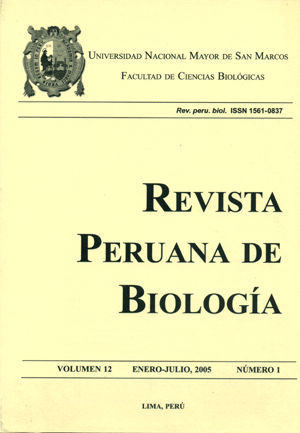Acute toxicity bioassays using Daphnia magna Straus (Cladocera, Daphniidae) maintained in a modified culture medium
DOI:
https://doi.org/10.15381/rpb.v12i1.2373Keywords:
Daphnia magna, ecotoxicological assays, chromium, cyanideAbstract
Daphnia magna is a test organism used in ecotoxicological assays of freshwater; however, traditional culture systems for this organism could result expensive, for that the aim of this research was to developed a new economic culture medium. With this purpose, 10 strains of D. magna were isolated, their population development was evaluated by total count of organisms and pregnant females using 3 different culture media: (A) alfalfa juice, (B) solved yeast and (C) a mixture of alfalfa juice plus solved yeast. Successful development of 4 strains was observed in the A medium, but the same strains failed to survive in the B and the C media. The 24h and 48h EC50 average values in acute ecotoxicological assays with potassium dicromate were 0,4045 mg/L ± 0,0389 and 0,1857 mg/L ± 0,0072 respectively. Also, acute ecotoxicological assays with these 4 strains were performed using potassium cyanide, which is a toxic reactive frequently used in mining operations. In this case 24h EC50 value was 1,5388 mg/L ± 0,1146 and 48h EC50 values were 0,6359 mg/L ± 0,0516. 48h EC50 values were lower than the cyanide permissible effluent values established by the Energy and Mining Authority.Downloads
Downloads
Published
Issue
Section
License
Copyright (c) 2005 Mónica Núñez, Jasmin Hurtado

This work is licensed under a Creative Commons Attribution-NonCommercial-ShareAlike 4.0 International License.
AUTHORS RETAIN THEIR RIGHTS:
a. Authors retain their trade mark rights and patent, and also on any process or procedure described in the article.
b. Authors retain their right to share, copy, distribute, perform and publicly communicate their article (eg, to place their article in an institutional repository or publish it in a book), with an acknowledgment of its initial publication in the Revista Peruana de Biologia.
c. Authors retain theirs right to make a subsequent publication of their work, to use the article or any part thereof (eg a compilation of his papers, lecture notes, thesis, or a book), always indicating its initial publication in the Revista Peruana de Biologia (the originator of the work, journal, volume, number and date).






